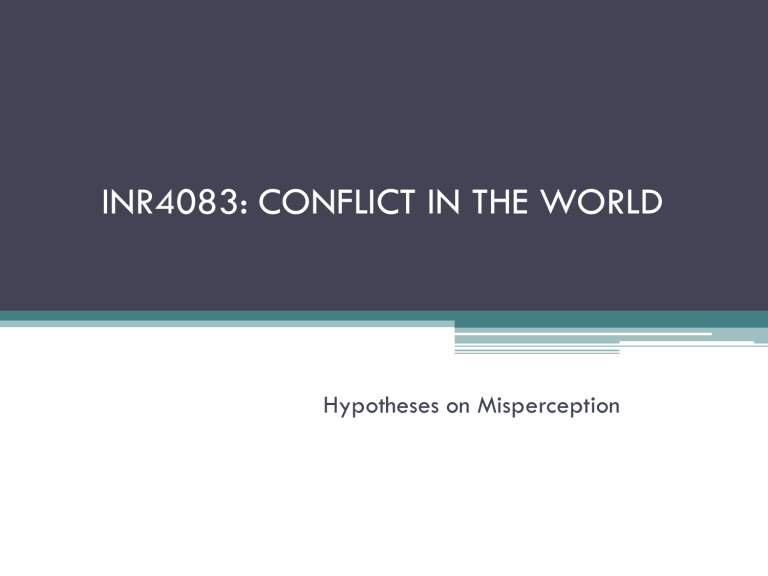
INR4083: CONFLICT IN THE WORLD Hypotheses on Misperception Rational Decision Making (in brief) • Rational national leaders • Complete information & accurate perception of international situation • Cost-benefit analysis • Best policy for national interests Ex: Graham Allison’s Rational Actor Model • Policy Makers: Unified National Actor • Policy-Making: a Rational Choice Maximizing national interest • Policy-Making Process Clarify FP Goals List Alternatives Estimate probable consequences of each option Choose the course of action Limits of Rational Model • FP Actors Not Unitary or Rational Interested in Organizational Interests • Incomplete Information & Strategic Interaction • Under Incomplete Information, Interpretation/perception on other’s intention/behavior matters Suspicion & emotional response Hypothesis 1: Theory vs. Data • Hypothesis 1: Decision-makers tend to fit incoming information into their existing theories and images ▫ The greater the ambiguity of data ▫ The higher the degree of confidence with which the actor holds the theory Hypothesis 2: Theory vs. Theory • Two conflicting ideas/information • Two ways to make mistakes ▫ 1. stick to the established view in the face of conflicting information ▫ 2. too easily change their views/beliefs ▫ 1 is more common than 2 Hypothesis 3: Data vs. Data • It is easier to integrate conflicting information into your image if it comes bit-by-bit than if it comes at once ▫ Misperception is greater when there is too much information Hypothesis 4: Missing Concept • Misperception is more serious in the case of a missing concept ▫ It is easier to correct misperception when there is a recognized concept Hypothesis 5: Different Backgrounds • Misperception/misunderstanding is likely when messages come from a different background of concerns or information than is possessed by the receiver. Hypothesis 6: Sending Messages • Decision-makers tend to believe that a message will be clear to the receiver, if they spend much time making a decision Hypothesis 7: Actions vs. Outcomes • Decision-makers often fail to realize that actions intended to project a given image may not have the desired effect because the actions themselves do not turn out as planned. Hypothesis 8: Hostile Images Decision-makers tend to perceive other states as more hostile than they are Hypothesis 9: Opponent • Decision-makers tend to believe that others are more centralized, disciplined, and coordinated than they are Hypothesis 10 • Decision-makers tend to take the foreign office’s position for the stand of the government as a whole ▫ A state gets most information about the other state’s policies from the foreign office Hypothesis 11 • When others act in accordance with our desires, we tend to give too much credits to ourselves for making them do so ▫ When others act against our desires, we tend to believe it came from domestic desires Hypothesis 12 • When actors have intention that they do not try to conceal from others, they tend to assume that others accurately perceive these intentions Hypothesis 13 • If it is hard for decision-makers to believe that the other can see them as a menace, it is often harder for them to see that issues important to them are not important to the other. Misperception & War: Five Examples • 1. Misperceiving the opponent as having more hostile intentions and as undertaking more hostile activities than is actually the case • 2. Misperception of the relative balance of power (perception that opponent is weaker or stronger than is the case) • 3. Perception that war is inevitable Cont. • 4. Perception that the war will be relatively inexpensive and short • 5. Misperception of the intensions/capabilities of third states Why Misperception? Two Answers • Cognitive Approach (Robert Jervis) Human cognitive limitations Over-simplification of problems in information-processing Premature cognitive closure • Motivational Approach (Irving Janis) Human beings are emotional (rather than rational calculation) Motivational impulse to maintain positive images of self For positive images, decision-makers employ threats of forces Under the expectation that the opponent will back down



